September 24, 2025

Best Smart Home Devices for Seniors: Make Life Easier and Safer
Getting older doesn’t mean you have to give up your independence or comfort at home. Smart home technology today provides seniors with valuable tools that make their lives safer, easier, and more peaceful, benefiting both them and their loved ones. These gadgets aren’t just for show; they’re meant to make life easier and safer.
Modern smart home devices are great because they can operate quietly in the background, allowing you to stay connected to family and emergency services when needed, while still maintaining independence. These technologies help you live the life you want by providing voice-activated assistants that can call for help and automated lighting that helps prevent falls.
Understanding Smart Home Benefits for Seniors
Smart home technology offers life-changing benefits that directly assist seniors in addressing the challenges they encounter as they age in place. These gadgets establish an invisible safety net that operates around the clock, monitoring your home and responding to your needs without requiring constant attention.
Smart home technology has specific benefits that make life easier every day:
- Enhanced safety: 24/7 monitoring for falls, medical emergencies, and home security threats.
- Better health management: reminders to take your medication, tracking your vital signs, and monitoring your health.
- More independence: voice-controlled help with tasks that could become hard to do physically.
- Family peace of mind: updates and alerts that let loved ones know how you’re doing in real time.
- Savings on costs: lower energy bills, fewer accidents, and less need for paid help.
These benefits work together to create a comprehensive support system that evolves with your needs over time.
Essential Categories of Smart Home Devices
There are several primary types of smart home devices for seniors, each serving a distinct purpose in daily life and enhancing safety.
When planning your smart home, the most important things to think about are:
- Safety and security systems: smart locks, video doorbells, medical alerts, and emergency monitoring.
- Monitoring health and wellness: fitness trackers, medication reminders, and tracking vital signs.
- Voice assistants, automated lighting, and convenience devices that help with daily living.
- Video calling systems and family connection tools enable people to communicate with each other and stay connected.
- The basics of home automation: managing energy, controlling the climate, and automating daily tasks.
Each category has its own purpose, but they work best when combined to form a complete support system.
Safety and Security Systems
For seniors, the most essential parts of a smart home are the safety and security devices. These systems are always on to keep you and your belongings safe and ensure you can get help quickly when you need it.
Innovative video doorbells like “Google Nest” or “Ring Hello” allow you to see and talk to people who come to your door without having to open it. Medical alert systems have undergone significant changes since the days when all you had was a pendant button. They can now find you with GPS and tell when you fall. Life Alert and other new systems can automatically tell when you’ve fallen and get help.
Smart locks allow family members or caregivers to enter without worrying about losing keys. When you walk around your house, motion-activated lights turn on automatically to light your way. It makes it much less likely that you will fall. Water leak detectors near water heaters can help you save money by alerting you immediately when they detect moisture.
Health and Wellness Monitoring
Health monitoring devices provide you with important information about your health every day, while still allowing you to maintain your privacy and independence. These tools help you and your healthcare providers make informed decisions about how to manage your health.
Fitbit Inspire and other basic fitness trackers track steps, heart rate, and sleep patterns without excessive features. Withings Body+ and other smart scales can automatically measure your weight and BMI, sending the data directly to your phone. Hero Health and other medication management systems use bright dispensers to sort pills and send reminders when it’s time to take them.
Daily Living Assistance
Daily living assistance devices make it easier to access information and services, as well as perform everyday tasks. These tools make your daily tasks easier, requiring no technical knowledge.
Amazon Echo and other voice assistants are the brains of your smart home. These devices can do more than just answer questions. With simple voice commands, they can make phone calls, set reminders for taking medicine, and call emergency services. Smart thermostats maintain a comfortable temperature while reducing energy costs. Programmable schedules and brightness controls are built into automated
lighting systems to ensure people’s safety and comfort.
Choosing the Right Devices for Your Needs
The best smart home devices for you will depend on your needs, budget, and comfort level with technology.
| Device Type | Best For | Price Range | Hard to set up | Main Benefits |
| Voice Help | Reminders every day and control without hands | $30 to $100 | Simple | Reminders for taking medicine, calling for help, and controlling the home |
| Doorbells with video | Screening visitors and keeping them safe | $100 to $300 | Moderate | See visitors safely, track their activity, and receive family alerts. |
| Systems for Medical Alerts | Detecting falls and responding to emergencies | $20 to $70 a month | Simple | GPS tracking, automatic fall detection, and 24/7 monitoring |
| Smart Lighting | Preventing falls and making things easier | $15 to $50 for each bulb | Simple | Automatic turning on, scheduling, and adjusting the brightness |
| Monitors for Health | Monitoring health and taking care of medications | $50 to $300 | Simple to Moderate | Health tips, reminders to take your medicine, and family sharing |
This comparison shows that voice assistants are the most flexible option for the money, while medical alert systems are the safest option, albeit at a monthly cost.
Implementation Tips for Seniors
To successfully integrate smart home technology, you need to take your time and be cautious about how you approach it.
Here are the most essential steps to make sure everything goes smoothly:
- Start with one device that meets your most critical needs, such as safety, health monitoring, or daily convenience.
- To ensure everything is set up correctly, consider asking a family member or friend who is knowledgeable about technology to assist you with the initial setup.
- Before considering additional purchases, practice using the device daily for at least a week.
- Keep customer service numbers and instruction manuals close at hand for when you need help.
- Select devices from well-known companies that offer customer service easy for seniors to use.
This step-by-step method helps you avoid feeling overwhelmed while also gradually improving your confidence and technical skills.
Addressing Common Concerns
For many seniors considering smart home devices, the fear of technology is the primary concern. But smart home devices today are made to be easy to use. Most of the time, all you have to do is plug them in and follow a few simple steps to set them up.
Seniors often don’t want to use smart home technology because they are worried that:
- Devices will be complex to learn or use.
- Not knowing how data is collected and how personal information is used.
- Smart home devices can be expensive and often come with hidden fees that continue to accumulate.
- Not being able to get help when something goes wrong.
- Being comfortable with the way things are now and not wanting to change familiar things.
Discussing these concerns directly often reveals that the benefits outweigh the initial doubts that most people have.
It’s essential to be concerned about privacy and security. Reputable companies use strong encryption to keep your private information safe. You shouldn’t let the cost stop you from getting technology that makes your life better and safer. Many devices pay for themselves by saving energy or preventing accidents.
Getting Started: Your First Smart Home Device
Choosing your first device based on your most pressing need is the first step toward a smarter, safer home.
Think about these well-known places to start:
- If safety is your primary concern, start with a video doorbell or a medical alert system.
- A voice assistant is one of the most useful and valuable tools for helping with daily tasks.
- To keep an eye on your health, start with a basic fitness tracker or smart scale.
- Bright lighting or a programmable thermostat is a good choice because it’s easy to use and saves energy.
Keep in mind that each new device you add makes the home environment more supportive by building on the ones that are already there.
Conclusion
Smart home technology provides older individuals with valuable tools to maintain their independence while enhancing the safety and comfort of their homes. These gadgets make your home work for you, helping you live the way you want to.
The secret to success is to start small, pick devices that meet your needs, and slowly build your smart home. Don’t let fear of technology stop you from using tools that can really make your life better. Smart home devices can help you stay in your own home with confidence, independence, and safety if you use them correctly and receive the proper support.

